Author: Ingeun, Source: Four Pillars Translation: Golden Finance
Key Points
Re-staking is a mechanism that allows users to reuse pledged assets to provide additional security for multiple blockchain networks or applications. This approach enables users to recycle their existing pledged assets, improve scalability and liquidity, while also earning additional rewards.
The re-staking stack is a conceptual framework that systematically classifies the main components of the re-staking ecosystem, including blockchain-based networks, pledge infrastructure, pledge platforms, re-staking infrastructure, re-staking platforms, and re-staking applications.
The re-staking infrastructure provides the technical foundation for implementing re-staking, allowing pledged assets to be used to protect other protocols or networks. Notable projects in this space include Ethereum’s EigenLayer, Bitcoin’s Babylon, and Solana’s Solayer. These projects focus on ensuring liquidity, enhancing security, and providing network scalability.
Restaking redefines blockchain security and is rapidly growing as an ecosystem. Its ability to increase scalability and liquidity through economic security makes it extremely attractive, although concerns remain about the risk and profitability of the restaking model.
The next post in this series will explore restaking platforms and applications that are critical to the potential mass adoption of the restaking ecosystem.
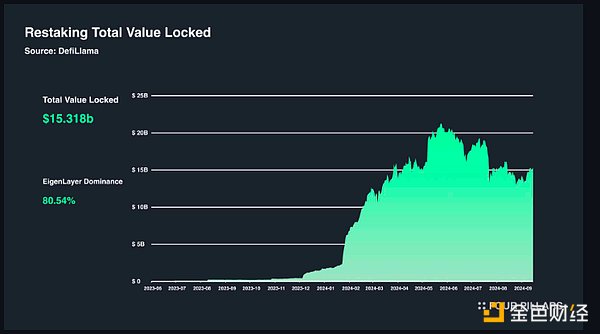
As of September 28, 2024, the total locked value (TVL) in the re-staking ecosystem led by EigenLayer is approximately $15.3 billion. This figure exceeds the $13 billion TVL held by crypto lending platform Aave and accounts for more than half of the TVL of leading Ethereum liquidity staking platform Lido ($26.48 billion). This highlights the amazing growth of the re-staking ecosystem.
Given this, you might be wondering what is attracting the interest of cryptocurrency holders and driving this growth. To answer this question, this two-part series aims to explain what restaking is, from which perspective the expanding restaking ecosystem is viewed, and the interesting projects within it.
This series begins with an overview of what restaking is, then defines the restaking stack centered around a robust restaking infrastructure, and explores the projects that fall under the restaking infrastructure and their unique characteristics.
1. Introduction to re-staking
1.1 Before re-staking
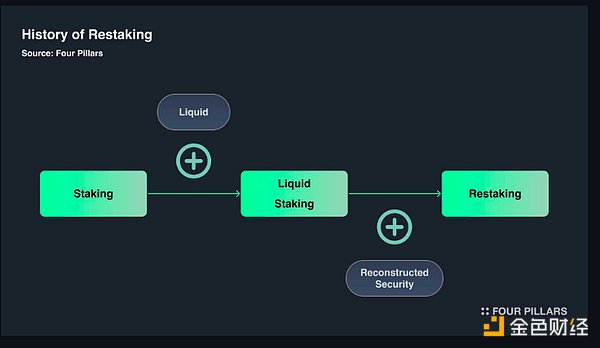
When Ethereum transitioned from Proof of Work (PoW) to Proof of Stake (PoS), along with the much-anticipated upgrade, The Merge, many ETH holders staked their ETH to support the stability of the network and receive staking rewards. This process led to the emergence of various staking services and platforms.
The first demand is a staking pool. The minimum 32 ETH required for staking presents a significant challenge for smaller Ethereum holders. To address this, staking pools were developed to allow people holding less than 32 ETH to participate in Ethereum staking.
The next issue is related to liquidity. When ETH is staked, the asset is locked in a smart contract, resulting in reduced liquidity. In the initial stages of the PoS transition, the staked ETH could not even be withdrawn, which effectively meant that the liquidity of the staked ETH was close to zero. To address this, services such as Lido and Rocket Pool issued Liquid Staking Tokens (LST). LST matches the value of the staked ETH, allowing stakers to use them as a proxy for their staked ETH in other DeFi services. In essence, LST allows users to regain some liquidity for their staked assets.
With liquidity secured through LST, new opportunities to leverage these tokens emerge. However, LST is primarily limited to the Ethereum DeFi ecosystem and is not used to secure extended networks built on Ethereum (e.g., L2). This introduces new challenges to Ethereum’s security model, such as:
Scalability Issues:Ethereum’s limited transaction processing capacity means that during periods of high demand, the network can become congested, leading to a significant increase in transaction fees. This makes it difficult for dApps and DeFi platforms to accommodate large numbers of users. Layer 2 (L2) solutions have emerged to address this issue, but they require their own security and verification mechanisms.
Additional Security Needed:Ethereum’s basic security mechanisms operate at the protocol level and rely on participants staking ETH to maintain network security. However, Ethereum’s built-in security is not always sufficient to meet the specific security needs of various L2s and applications, so additional layers of security are needed for each application.
Liquidity Limitations:While Ethereum’s adoption of PoS activated the staking mechanism, a key issue remains: the staked assets are used only for network security. For example, staked ETH cannot be used for other useful functions or applications. This limits liquidity and restricts the ability of network participants to explore additional income-generating opportunities.
These challenges highlight the need for a new security mechanism that fits the current state of Ethereum and PoS blockchains.
1.2 The Rise of Re-Staking
The need for new security methods ultimately led to the concept of re-staking.
“Restaking is the latest answer to the core security problem of cryptocurrencies: how to use economic games to protect decentralized computing systems.”
As described in the quote, restaking uses principles of financial engineering to enhance blockchain security through economic security.
Before diving into restaking, it is important to understand how PoS blockchains maintain security. Many blockchains, including Ethereum, have adopted PoS, and one common attack method is for an adversary to accumulate enough staked assets to affect the network. The cost of hacking a blockchain is usually proportional to the total value staked in the network, which can act as a deterrent.
Restaking takes this concept one step further, aiming to apply economic security more broadly. In major protocols such as Ethereum, a significant amount of capital has already been staked. Restaking repurposes these funds to provide enhanced security and functionality at the L2 or application level. Due to the added security benefits, restaking can earn greater returns than through traditional staking alone. As a result, restaking can address the challenges outlined above:
Scalability:Restaking allows L2 solutions and other applications to leverage the security of the primary blockchain’s staked resources. This allows L2 solutions to maintain a higher level of security without having to build an independent mechanism, but instead leveraging staked capital from the mainnet.
Enhanced Security:Restaking allows the staked resources of the primary blockchain to be used not only to secure the mainnet, but also to validate and secure functionality at the application level. This creates a more robust and comprehensive security framework.
Liquidity Enhancement:Restaking aims to allow staked mainnet assets to be repurposed for other uses. For example, staked assets can be used for validation tasks across different networks or applications, increasing the overall liquidity and utility of the security ecosystem while providing additional rewards to participants.
In summary, restaking emerged in response to the limitations of PoS mainnets such as Ethereum, and aims to enable these networks to support more participants while providing enhanced security and liquidity.
A notable early implementation of the restaking concept is Inter-Chain Security (ICS). Cosmos operates an ecosystem where multiple independent blockchains interact through the concept of cross-chain. However, each chain must maintain its own security, which brings burdens. ICS solves this problem by allowing blockchains in the Cosmos ecosystem to share security resources.
The Cosmos Hub’s validators are responsible for securing the network, and new or small chains can leverage this security without having to build their own validator network. This approach reduces security costs and helps make it easier to launch new blockchain projects in the Cosmos ecosystem. However, challenges such as increased infrastructure costs, limited utility of native tokens, and high profitability requirements for consumer chains have limited the overall success of ICS.
Nevertheless, these efforts paved the way for EigenLayer in the Ethereum ecosystem, which has now become a leader in the restaking industry. Therefore, to thoroughly understand restaking, studying EigenLayer, which is deeply rooted in the Ethereum ecosystem, is a good starting point. Let’s take a deeper look at EigenLayer and the restaking ecosystem.
1.3 Example via EigenLayer
1.3.1 From Fragmented Security to Reconstructed Security
How does restaking fundamentally provide stronger security and liquidity?
“If I have seen further, it is because I have stood on the shoulders of giants.”
This famous quote by Isaac Newton acknowledges the contributions of past scientists to his achievements. More broadly, this quote suggests that “leveraging existing resources is often a wise choice.” Currently, many blockchain services rely on large L1 networks, leveraging their ecosystems, trust, and security resources. However, choosing a less mature network or trying to become a major player independently can be risky, as these projects may fail before they reach their full potential. To illustrate this with EigenLayer, let’s consider the scenario shown in the figure below. The two ecosystems in the figure each have $13 billion in staked capital. On the left, Ethereum and Actively Validated Services (AVS, a middleware network service) are not interconnected, while on the right, Ethereum and Actively Validated Services are interconnected via EigenLayer.
Left Ecosystem:Here, Ethereum and AVS are not directly connected, so while value can be transferred between networks via the bridge, this has nothing to do with shared security. As a result, Ethereum and AVS cannot share economic security, leading to security fragmentation. Attackers may target networks with the lowest staked capital. This leads to security fragmentation where the cost of corruption (CoC) is aligned with the minimum required amount. This situation creates a competitive environment between services, rather than synergy, and can undermine Ethereum's economic security.
Right Ecosystem:What would happen if Ethereum and AVS were interconnected? EigenLayer answers this question by integrating Ethereum and AVS through the concept of re-staking, merging fragmented security into a reconstructed form. This integration has two benefits: AVS services can share the capital of the Ethereum network instead of competing for it, and all AVS services can take advantage of shared economic security. This effectively creates an environment where these "giants" unite and allow them to see further together.
1.3.2 Pillar of Restaking (Feat. EigenLayer)
With this explanation, we can understand that AVS services can inherit the economic security of Ethereum, thereby gaining significant security at a lower cost. However, this complex financial ecosystem relies on various roles to operate smoothly. Let's delve into these roles:
Active Validation Service (AVS): AVS is a service that requires a decentralized verification system, such as a DA layer, sidechain, or oracle network. AVS relies on node operators to maintain network security by reliably running nodes. AVS uses two mechanisms: slashing (confiscation of part or all of the staked amount due to poor performance) and rewards (rewards for successful operations). AVS can leverage the security of Ethereum with re-staked ETH without having to build a separate trust network.
Re-stakers:Re-stakers are entities that re-staked native ETH or LST staked on the Ethereum beacon chain. If re-stakers are unsure about choosing a specific AVS or seeking additional rewards, they can delegate the re-staked capital to node operators. In this case, re-stakers delegate their capital to nodes operated by node operators and receive re-staking rewards from them.
Node Operators:Node operators receive delegated re-staked funds from re-stakers and operate nodes to perform the validation tasks required by AVS. Node operators use the re-staked funds to build and run nodes with enhanced security. They play a vital role in maintaining the reliability and security of AVS, and in return receive re-staking and node operation rewards.
1.3.3 Merge into One
EigenLayer integrates these roles into an open market structure, allowing each role to operate freely based on economic principles.
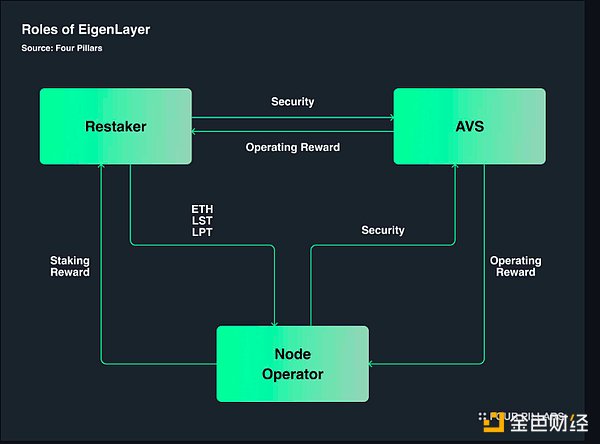
Under this setup, re-holders delegate their assets (such as ETH, LST, or LPT) to node operators, who then use their nodes to protect AVS services and earn rewards. At the same time, AVS pays operating rewards to node operators in recognition of their security contributions, thereby ensuring network security and trust.
1.3.4 Strengthening the Re-Pledge Ecosystem
EigenLayer is a typical example of re-staking, providing a comprehensive understanding of the concept. Most of the emerging restaking services closely follow the core principles of restaking, making EigenLayer a useful reference for understanding the restaking model.
With EigenLayer at the forefront, the restaking ecosystem is expanding. This growth is not just in size; the ecosystem is becoming more nuanced, with more specific roles and categories emerging. This gives us a deeper understanding of the expanding ecosystem. In the next chapter, we will take a closer look at the restaking stack and explore the projects in each category.
2. The Restaking Stack
Since the restaking ecosystem is still actively developing, it can be challenging to clearly delineate each category. However, as the ecosystem matures and its position stabilizes, it will foster the development of more advanced projects. Using existing data and my insights, I will introduce a framework for categorizing the restaking ecosystem - the restaking stack.
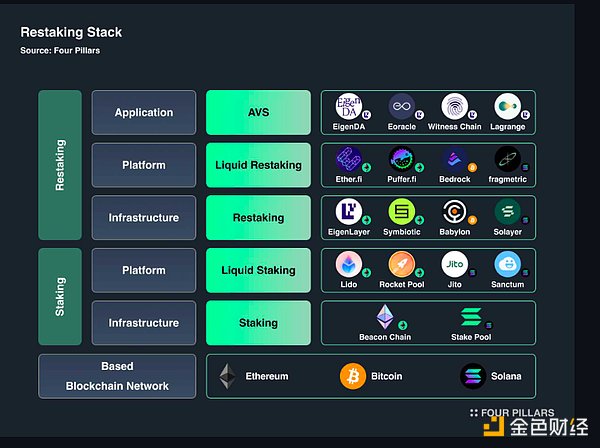
2.1 Based on blockchain network

Ethereum: Ethereum is the main re-staking blockchain network and plays a key role in the ecosystem. With its PoS system and smart contract capabilities, Ethereum provides users with the opportunity to use their native ETH through platforms such as EigenLayer to participate in various re-staking activities.
Bitcoin: Bitcoin adopts the PoW mechanism and lacks the native staking function unique to PoS blockchains. Nonetheless, due to its global adoption and strong security, initiatives like Babylon aim to integrate Bitcoin’s massive capitalization into the re-staking ecosystem, leveraging its economic security to support other blockchains. Projects like Babylon allow for the use of Bitcoin’s capitalization without the need for wrappers or bridges, enabling Bitcoin staking directly from their blockchain.
Solana: Known for high performance and low transaction costs, Solana provides a favorable environment for staking, DeFi, NFTs, and re-staking. As Solana’s staking infrastructure continues to develop, platforms like Solayer are emerging that aim to establish a prominent position for Solana in the re-staking ecosystem by providing a unique re-staking model tailored to Solana’s strengths.
2.2 Staking Infrastructure

The staking infrastructure layer includes systems that allow participants to stake their native tokens, thereby helping to improve the security and efficiency of the blockchain network. These infrastructures are at the core of the PoS-based consensus mechanism, enabling the decentralized process of block verification and generation. Participants stake their assets to become validators, helping to maintain network stability and earn rewards. In addition, the staking infrastructure monitors the behavior of validators and enhances security by slashing penalties for improper behavior.
Beacon Chain:The Beacon Chain plays a vital role in the Ethereum network, which has transitioned to PoS, improving scalability, security, and energy efficiency. Unlike the previous Ethereum based on PoW, the Beacon Chain runs around validators who stake native ETH. It selects validators and manages the process of proposing and validating blocks. This shift reduces the high energy consumption of PoW-based mining while maintaining the decentralization of the network and improving efficiency. In addition, the Beacon Chain supervises users participating as validators by locking up the staked native ETH and monitors whether validators are correctly validating blocks. If validators misbehave, they will face penalties through a process called slashing, which involves confiscating their staked ETH.
Stake Pools: Solana’s stake pools enhance network security and simplify the process for users to participate in staking. They aggregate smaller SOL stakes, allowing users to collectively support a single validator. Through this process, users who delegate their stake to validators are rewarded as those validators create blocks or verify transactions. Stake pools also improve network stability by distributing staked SOL to reliable validators.
2.3 Staking Platform

The staking platform layer includes services that enable users to contribute to the security and operation of the blockchain network while maintaining the liquidity of their assets. These platforms play a key role in PoS blockchains by providing simple services that allow users to stake native tokens and earn rewards. In addition to locking assets, staking platforms also provide liquidity staking, which is to tokenize the staked assets so that users can use these assets in DeFi services. This structure enables users to maintain liquidity while participating in network operations and maximizing rewards. Through these features, staking platforms simplify the user experience and make it easier for more users to participate in staking.
Lido: Lido is one of the most popular liquidity staking platforms in the Ethereum ecosystem, allowing users to stake their native ETH and receive stETH in return. This liquidity token maintains the value of the staked ETH, enabling users to earn additional rewards through other DeFi services. Lido's focus on Ethereum has since expanded to support networks such as Polygon's PoS network.
Rocket Pool: Rocket Pool is a community-owned decentralized staking platform for Ethereum that is compatible with native ETH staking. The platform was originally conceived in 2016 and launched in 2021 to provide a solution for users who do not have the technical ability to run a node or the financial resources to meet the 32 ETH requirement. Rocket Pool is committed to building a liquid and reliable platform that allows users to leverage their staked assets across a variety of services.
Jito: Jito is Solana's liquid staking platform that provides users with MEV (Maximum Extractable Value) rewards. Users can stake their native SOL through Jito's staking pools and earn JitoSOL tokens, which remain liquid while accumulating staking and MEV rewards. Jito aims to optimize returns for users holding JitoSOL and contribute to enriching the Solana DeFi ecosystem.
Sanctum: Sanctum builds on Solana's fast and low fees, providing enhanced security as a staking platform through an open source and multi-signature framework. It allows users to use staked SOL in DeFi services. By integrating liquidity from various LST pools, it solves the liquidity fragmentation problem and enables users to access richer liquidity pools. Notably, through the Infinity Pool, users can deposit LST or SOL, receive INF tokens, and simplify staking and liquidity provision. In addition, Sanctum also runs a rewards program called Wonderland, which encourages users to actively participate by providing points and rewards for performing specific tasks or using the platform.
2.4 Re-pledge Infrastructure

The re-pledge infrastructure layer is critical to enhancing the economic security of blockchain networks, providing scalability and flexibility. It enables users to reuse pledged assets to protect multiple networks or applications, providing re-pledgers with the opportunity to participate in a variety of services while maximizing returns. Applications built on top of this infrastructure can leverage re-pledged assets to protect a more robust security framework and expand their functionality.
The re-pledge infrastructure also supports re-pledge platforms and applications, allowing them to create customized pledge and security models. This enhances scalability and interoperability across the blockchain ecosystem, positioning restaking as a critical technology for sustaining the decentralized web.
Below are some examples, and Chapter 3 provides more details on the restaking infrastructure.
EigenLayer: EigenLayer is a restaking infrastructure built on Ethereum that enables users to restake their native ETH or LST to secure other applications and earn additional rewards. By reusing staked ETH across a variety of services, EigenLayer reduces capital requirements for participation while significantly increasing the credibility of individual services.
Symbiotic: Symbiotic is a restaking infrastructure that provides an open and accessible shared security model for the decentralized web. It enables builders to create custom staking and re-staking systems with modular scalability and decentralized operator rewards and slashing mechanisms, providing enhanced economic stability to the network.
Babylon: Babylon connects Bitcoin’s strong economic security with other blockchains, such as Cosmos, with the goal of strengthening security and facilitating cross-chain interoperability. Babylon’s integration allows for safer transactions through the networks it connects, leveraging Bitcoin’s proven security. It leverages Bitcoin’s hash power to enhance finality and provides a suite of protocols for securely sharing Bitcoin’s security with other networks.
Solayer: Solayer is built on the Solana network, leveraging economic security to scale appchains, providing custom blockspaces and efficient transaction alignment for application developers. It leverages re-staked SOL and LST to maintain network security while enhancing specific network features, designed to support scalable application development.
2.5 Re-pledge Platform

The re-pledge platform layer includes platforms that provide additional liquidity or combine re-pledged assets with other DeFi services, enabling users to maximize their returns. These platforms typically issue Liquid Re-Pledge Tokens (LRT) to further enhance the liquidity of re-pledged assets. They also promote user participation in re-pledge through flexible management models and reward systems, thereby contributing to the stability and decentralization of the re-pledge ecosystem.
Ether.fi: Ether.fi is a decentralized re-staking platform that allows users to directly control their re-staking keys. It provides a service marketplace for node operators and re-stakers to interact. The platform issues eETH as a liquid staking token and seeks to decentralize the Ethereum network through a multi-step re-staking process and node service configuration.
Puffer.fi: Puffer.fi is a decentralized native liquidity re-staking platform based on EigenLayer. It allows anyone holding less than 32 ETH to stake their Ethereum native tokens to maximize returns through integration with EigenLayer. Puffer.fi provides high capital efficiency, providing liquidity and PoS rewards through its pufETH token. Re-stakers can earn stable returns without complex DeFi strategies, while Puffer.fi's security mechanism ensures asset safety.
Bedrock: Bedrock has partnered with RockX to develop a liquidity re-pledge platform that supports multiple asset types. It provides additional rewards by re-pledge assets such as wBTC, ETH, and IOTX. For example, uniBTC re-pledges BTC for the security of the Ethereum network, while uniETH re-pledges ETH in a similar manner to maximize rewards through EigenLayer. Bedrock uses a capped token structure that prevents total issuance from growing, aiming to increase token value over time.
Fragmetric: Fragmetric is a liquidity re-pledge platform in the Solana ecosystem that leverages Solana’s token scaling capabilities to solve reward distribution and slashing rate issues. Its fragSOL token sets a new standard for re-pledge on Solana, providing a platform structure that enhances both security and profitability.
2.6 Re-pledge Application

The re-pledge application layer includes decentralized services and applications that use re-pledged assets to enhance the security and functionality of existing blockchain infrastructure. These applications leverage re-pledge to ensure economic security while focusing on providing specific functions such as data availability storage, oracles, physical infrastructure verification, and cross-chain interoperability.
By allowing validators on Ethereum and other blockchain networks to re-pledge assets across multiple services, re-pledge applications can reduce capital costs while improving security and scalability. They also ensure data integrity and security through decentralized processes, applying economic incentives and penalties to ensure reliability. These applications enhance the scalability and efficiency of blockchain systems and promote interoperability between different services.
EigenDA: EigenDA is a highly scalable Data Availability (DA) storage solution for Ethereum rollups, integrated with EigenLayer. EigenLayer requires operators to stake a security deposit to participate, penalizing those who fail to properly store and verify data. This incentivizes decentralized and secure data storage, and the scalability and security of EigenDA are enhanced by EigenLayer's re-staking mechanism.
Eoracle: Eoracle is an oracle service in the EigenLayer ecosystem, leveraging re-staked ETH and Ethereum validators to provide data verification. Eoracle aims to create a decentralized competitive market for data providers and users, automating data verification and enabling smart contracts that integrate external data sources.
Witness Chain: Witness Chain supports the development of new products and services for various applications and decentralized physical infrastructure networks (DePIN). It uses the DePIN Coordination Layer (DCL) module to convert physical properties into verifiable digital proofs. In the EigenLayer ecosystem, EigenLayer operators run DePIN Challenger Clients, ensuring a reliable environment for their verification process.
Lagrange: Lagrange is the first zero-knowledge AVS on EigenLayer. Its National Committee is a decentralized node network that uses zero-knowledge technology to provide security for cross-chain interoperability. Lagrange's ZK MapReduce solution supports efficient cross-chain operations while maintaining security and scalability. It strengthens cross-chain messaging and rollup integration, leveraging EigenLayer's economic security to improve performance.
Through this overview of the re-staking stack and project examples, we see that as the re-staking ecosystem matures, it becomes more structured, providing a deeper understanding. How to take a closer look at these emerging categories? In this series, we will first focus on the re-staking infrastructure, and other components will be introduced in the next part.
3. The ecosystem of the re-staking infrastructure
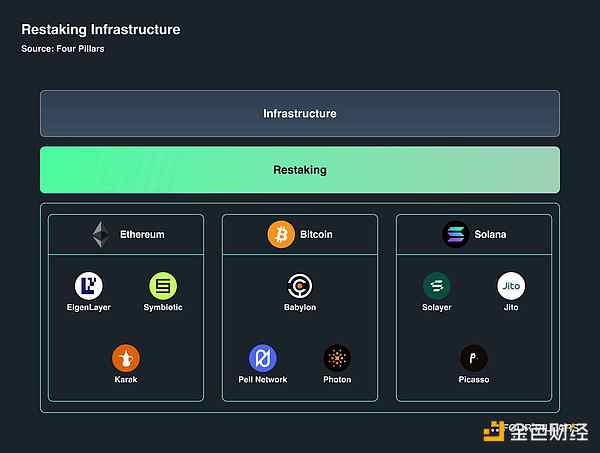
The re-staking infrastructure is a foundational framework that supports the reuse of staked assets across different networks and protocols to enhance network security and maximize utility. As the concept of re-staking becomes more popular, major blockchain networks such as Ethereum, Bitcoin, and Solana have developed infrastructures that are suitable for their unique characteristics. In this section, we will explore the reasons for the emergence and development of restaking infrastructure in each network, the advantages and challenges they face, and the impact of various projects on the restaking infrastructure.
3.1 Ethereum
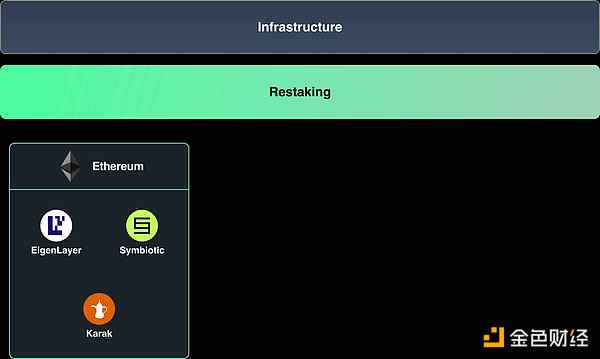
During the "The Merge" upgrade, Ethereum transitioned from PoW to PoS, laying the foundation for the development of restaking infrastructure. Ethereum's PoS model relies on staked assets to ensure network security, but the ability to re-use these assets for other protocols has greatly increased people's interest in restaking.
Ethereum's main focus is scalability, and it has been achieving this goal through L2 solutions. However, as Ethereum founder Vitalik Buterin pointed out, this approach has led to security fragmentation, which ultimately weakens Ethereum's security model. EigenLayer becomes the first solution to solve this problem through economic security, allowing staked Ethereum assets to be used in other protocols to enhance security and scalability.
EigenLayer provides Ethereum asset re-pledge services across different protocols while maintaining basic security and leveraging a large network of operators to achieve stable economic security. It supports native ETH re-pledge and plans to expand to LST and ERC-20 tokens, providing potential solutions to Ethereum's scalability challenges.
The concept of re-pledge is spreading in the Ethereum ecosystem, and other projects are also working to solve Ethereum's limitations. For example, Symbiotic enhances Ethereum's security by integrating with other DeFi services. In collaboration with Ethena Labs, Symbiotic supports a wide range of asset re-pledges, including LSTs such as wstETH, as well as assets such as sUSDe and ENA. This allows users to provide additional security resources through re-pledge and improve Ethereum's PoS security. Additionally, Symbiotic issues ERC-20 tokens such as LRT to provide a flexible reward structure, allowing the efficient use of re-pledged assets in various protocols.
Another re-pledge infrastructure, Karak, aims to address Ethereum's structural inefficiencies that pose a challenge to re-pledge operations. Karak provides multi-chain support, enabling users to deposit assets across chains such as Arbitrum, Mantle, and Binance Smart Chain. It supports re-pledge of ERC-20 tokens, stablecoins, and LST in a multi-chain environment. Karac uses its own L2 chain to store assets, maximizing scalability while maintaining security.
3.2 Bitcoin
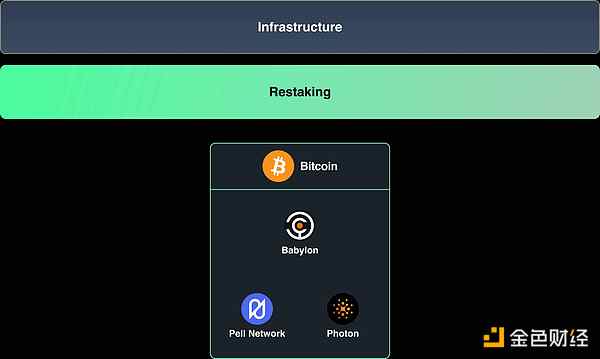
Bitcoin, as a PoW-based network, has different characteristics from PoS-based networks, where the staked assets are directly related to security. However, Bitcoin's dominance in terms of market capitalization has led to the development of re-staking concepts that use Bitcoin's economic security to generate additional income in other blockchains. Projects such as Babylon, Pell Network, and Photon use various methods to integrate Bitcoin's security into their own ecosystems, thereby enhancing its scalability.
Bitcoin's PoW system is one of the most secure in the world, making it a valuable asset for re-staking infrastructure. Babylon uses Bitcoin's staking and re-staking capabilities to enhance the security of other PoS blockchains. It converts Bitcoin's economic value into economic security to provide protection for other blockchains. It operates its own PoS chain using the Cosmos SDK, supporting non-custodial staking and re-staking directly from the Bitcoin blockchain without the need for third-party trust.
Bitcoin also faces challenges with liquidity and additional income opportunities. Pell Network was founded to provide liquidity and income opportunities for Bitcoin holders, leveraging cross-chain technology to integrate Bitcoin into the DeFi ecosystem for additional gains.
The most significant limitation of Bitcoin is the lack of native smart contract support. While PoW provides strong security, its design makes it difficult to program internally through smart contracts. Photon solves this problem by extending Bitcoin's ability to execute smart contracts without changing its core structure, enabling staking and re-staking directly on the Bitcoin mainnet. This ensures that all staking and re-staking related processes are verified on the Bitcoin mainnet, maintaining Bitcoin's high security while providing flexible staking options.
3.3 Solana
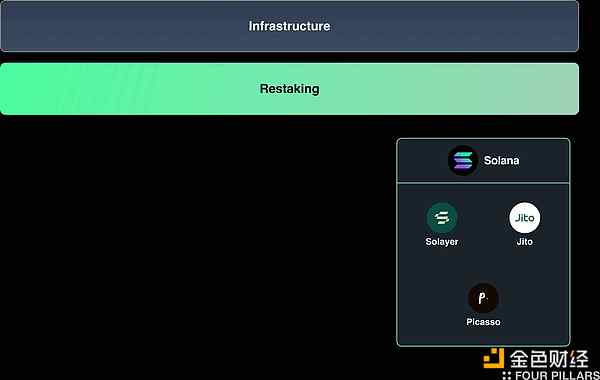
Solana is known for its high transaction throughput and low fees, which makes it an ideal environment for the development of re-staking infrastructure. Multiple projects in the Solana ecosystem have adopted a re-staking model to maximize these advantages.
Solana's rapid growth directly benefits validators, but it has been a challenge to fairly distribute economic benefits in the broader Solana ecosystem. Solayer solves this problem by providing a re-staking infrastructure focused on economic security and execution to expand the application chain network, providing a framework for staking native SOL and LST to support application-specific networks. It also allows users to re-use their staked assets on other protocols to maximize returns.
Since Solayer draws inspiration from Ethereum’s restaking infrastructure, such as EigenLayer, it takes a similar approach to user convenience while tailoring its restaking model to Solana’s unique properties. This ultimately aims to drive growth in the Solana ecosystem.
Jito has been recognized for its role in Solana’s staking infrastructure and is currently working to expand its influence into the restaking space. Jito is building its restaking service on top of its existing Solana infrastructure, which has generated a lot of interest from users for its potential scalability and reliability. Jito’s vision is to leverage SPL-based assets through a restaking solution and optimize MEV during the block creation process. This improves security while providing more earning opportunities for restakers.
Picasso complements Solana’s scalability by building a cross-chain scaling framework and restaking mechanism. Picasso is developing a restaking layer not only for Solana, but also for the Cosmos ecosystem, introducing an extended concept that allows users to restake assets across multiple PoS networks. It aims to bring the restaking ecosystem that was previously limited to Ethereum to the Solana and Inter-Blockchain Communication (IBC) ecosystem, providing tailored restaking services with a grand vision.
3.4 Increasingly complex restaking infrastructure
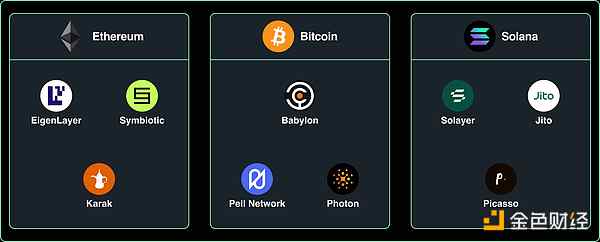
In this way, restaking infrastructure projects on networks such as Ethereum, Bitcoin, and Solana have developed by leveraging the strengths and weaknesses of their respective ecosystems. These projects demonstrate the potential for restaking infrastructure to play an important role in the future blockchain ecosystem as their networks evolve.
Projects such as Eigenlayer, Symbiotic, and Karak have made significant contributions to solving Ethereum's scalability issues and enhancing its security. At the same time, projects such as Babylon, Pell Network, and Photon have used Bitcoin's security in various ways to further develop the concept of restaking. In addition, projects such as Solayer, Jito, and Picasso have used Solana's unique characteristics to restake more efficiently, which has also had a positive impact on network scalability.
4. Looking to the Future - A New Form of Network Security Based on Financial Engineering
In this series, we explored the basics of restaking, defined the restaking stack, and examined the ecosystem of restaking infrastructure. Just like the growth of L2 solutions, the restaking infrastructure is also developing around the core blockchain network and constantly working to enhance its functionality. As the scale of the restaking ecosystem continues to expand (represented by its growing TVL), an independent ecosystem is taking shape.
An important factor in the growth of rehypothecation is its reliance on financial engineering rather than purely technical characteristics. Unlike traditional staking infrastructure, rehypothecation infrastructure is more flexible and can accept a wider range of asset types. However, this flexibility brings new economic structures and risks that are different from traditional blockchain operations.
A major risk is that rehypothecation is essentially a derivative financial asset rather than a core financial asset. Some people see rehypothecation as a promising investment opportunity and a new advancement in the field of crypto security, while others believe that it is a rehypothecation model with too rich returns and higher risks. In addition, the rehypothecation infrastructure has not yet experienced extreme market tests, such as the pressure of the "crypto winter", which raises questions about its potential stability.
If this stability cannot be confirmed, rehypothecation may be criticized for the risks inherent in its rehypothecation model. In addition, the ecosystem has not yet expanded enough to establish the economies of scale required for a sustainable business model, which remains a challenge.
Nevertheless, the rapid growth of the restaking ecosystem, and in particular the restaking infrastructure, is undeniable. This momentum is supported by the increasing structure of the ecosystem. As the ecosystem develops, concerns about profitability may be addressed, ultimately positioning the restaking infrastructure as a key player in cryptocurrency and blockchain security.
The categorization and definition of the ecosystem suggest that it is ready to enter the next phase of development. The emergence of the Restaking Stack reflects the significant progress made by individual projects in developing narratives and products.
Now that the restaking infrastructure has been perfected, the focus will shift to the restaking platforms and applications that will determine the success or failure of the mass adoption of the restaking ecosystem. Therefore, the next article in this series will take a deep dive into restaking platforms and applications, exploring their potential to drive widespread adoption of the ecosystem.
 Kikyo
Kikyo



















